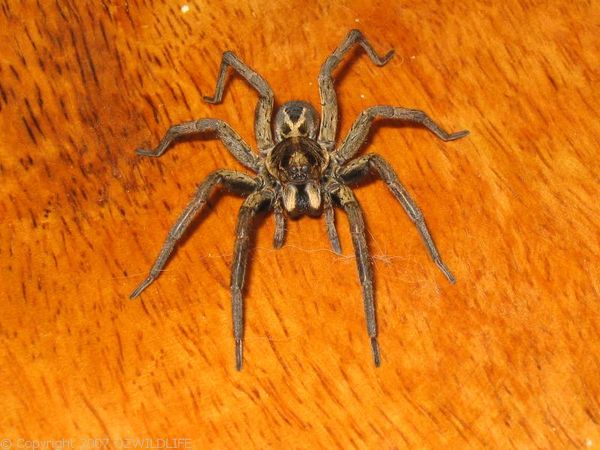|

The Wolf Spider was photographed in a wooden fruit bowl. (Wolf spiders are not good climbers).
Photograph copyright: ozwildlife - all rights reserved. Used with permission.
|

Wolf Spider. Wolf spider photographed in our kitchen. It is not that uncommon to find one indoors - I relocated this one outdoors (alive!) after photographing.
Photograph copyright: ozwildlife - all rights reserved. Used with permission.
|

Wolf Spider. This is one of the larger ones commonly found around the garden. This one was about 2cm long.
Photograph copyright: ozwildlife - all rights reserved. Used with permission.
|

Wolf Spider. Close up showing head and eyes. The Wolf has two big eyes at front of its head.
Photograph copyright: ozwildlife - all rights reserved. Used with permission.
|

Wolf Spider. This was quite a small one - about 1cm long. These are often uncovered when gardening.
Photograph copyright: ozwildlife - all rights reserved. Used with permission.
|

This female Wolf Spider is carrying its young on its back. This specimen was about 15mm long. The babies would have been about 2mm long.
Photograph copyright: ozwildlife - all rights reserved. Used with permission.
|
|
|
WOLF SPIDER FACTS |
Description
The Wolf Spider is a hunting spider. Body colours are typically dark grey or brown, with bars of tan, yellow or black. May have pattern of radiating lines on thorax. The spider's underside is lighter coloured. The sides of their jaws have a small raised orange spot. Wolf spiders have eight eyes in three rows, with the four smaller eyes in front and the four largest arranged in a square on top of the head.
They are robust, agile hunters that live on the ground in leaf litter or burrows. They are not good climbers
Size
to 25 mm in body length
Habitat
Ranges from dry inland shrublands and woodlands to wet coastal forests and alpine meadows. They are often found in lawns and gardens and sometimes crawl into homes.
Food
Insects such as crickets and cockroaches, small lizards and small frogs. According to the Queensland Museum, two Wolf spider species are known to be predators of cane toads
Breeding
Mating takes place outside the female's burrow at night. The female constructs a ball-shaped egg sac of white papery silk. She carries it around attached with strong silk to her spinnerets. When the spiderlings hatch, they are carried around on the female's back until they are ready to disperse. Wolf spiders live for up to two years.
Range
Wolf spiders are found throughout Australia.
Notes
Bite is usually harmless with some local pain or itchiness. Less common symptoms include swelling, prolonged pain, dizziness, rapid pulse and nausea.
Classification
| Class: | Arachnida | | Order: | Araneomorphae | | Family: | Lycosidae | | Genus: | Lycosa | | Species: | sp | | Common Name: | Wolf Spider |
|
|

